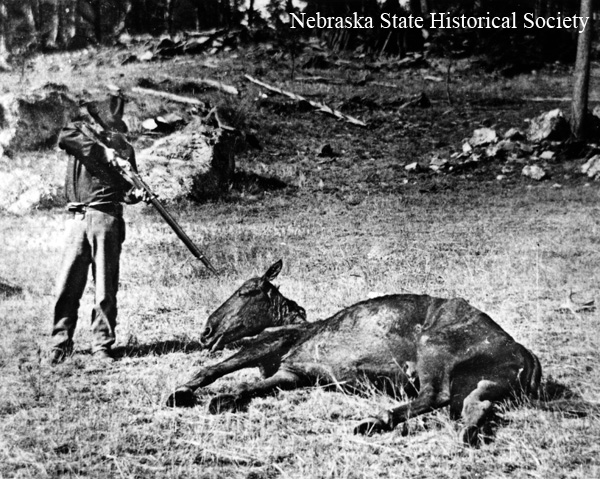Note: the word Indian is used instead of Native American as it was the norm at the time.
Imagine your car. Now consider the amount of gas that it requires to keep it running. Picture that your car is in the middle of rural, untamed Nebraska: there are no gas stations for miles. Multiply your car into several hundred cars, and imagine you must organize a large group of men to drive them. You will be doing your best to chase down and capture men driving another group of cars. These other men know the landscape, and their cars run on grass instead of gasoline. What’s more, their drivers hate you, and attack any gas stations that you don’t guard. Oh, and your cars break down if you drive them too far or too fast. You get replacement cars occasionally, but sometimes, just for fun, your replacement cars come with wheels of different sizes.
Sounds absurd, doesn’t it? But imagine with me just a little longer. Turn the cars into horses, the fuel into corn, and the wheels into horseshoes. Turn your car drivers into soldiers, and the other cars’ drivers into Indians. You now have a fairly accurate picture of the problems facing U.S. soldiers in the American west during the 1864 and 1865 on the forgotten front of the Civil War.
The soldiers stationed in the West were there primarily to make sure that the U.S. government could stay in close contact with the western states and territories, which provided much of the gold and silver that financed the war effort. The most reliable form of communication was the transcontinental telegraph, which stretched for hundreds of miles across the Great Plains, followed by the stagecoaches that carried the U.S. mail. However, the Native Americans of the region took every opportunity to attack these lines and surrounding settlements, attempting to undermine the white government that was steadily usurping their land. Protecting the telegraph lines and other assets was vital, not only for communication, but also to protect the territories from potential Confederate attacks. Among those sent to combat these difficulties were the First Nebraska Volunteer cavalry.
 In the Winter 2011 edition of Nebraska History, James Potter explores the U.S. Army’s Plains campaigns during this time in his article Horses: The Army’s Achilles’ Heel in the Civil War Plains Campaigns of 1864-65. Specifically, Potter researches one crucial element of the Civil War on the Plains that is often overlooked: the horses that were provided to the troops. Because of the Civil War, horses were used up at an alarming rate. By 1864, good horses were difficult to find, and most of those went to the Union Armies fighting Confederates in the East. When the government did obtain horses for the cavalry, many were unfit for service. Some of the horses provided had never even been ridden, and were often unruly and skittish.
In the Winter 2011 edition of Nebraska History, James Potter explores the U.S. Army’s Plains campaigns during this time in his article Horses: The Army’s Achilles’ Heel in the Civil War Plains Campaigns of 1864-65. Specifically, Potter researches one crucial element of the Civil War on the Plains that is often overlooked: the horses that were provided to the troops. Because of the Civil War, horses were used up at an alarming rate. By 1864, good horses were difficult to find, and most of those went to the Union Armies fighting Confederates in the East. When the government did obtain horses for the cavalry, many were unfit for service. Some of the horses provided had never even been ridden, and were often unruly and skittish.
By 1864 Indians were a greater threat to the telegraph and stagecoach lines. It was the soldiers’ job to protect them, a job made more difficult by their poor horses. Procuring able-bodied horses was not the only difficulty. Unlike the Indian ponies that could survive only on prairie grass, the cavalry horses also required large amounts of corn and hay. Providing this corn necessitated long, clumsy wagon trains of supplies, which were also frequent targets for Indian raids. As a result, the cavalry regiments in the West rarely had the grain they needed to feed their horses.

Soldiers resorted to killing their exhausted mounts for food during Gen. George Crook’s 1876 campaign against the Lakota, a level of hardship reminiscent of the Plains campaigns of 1864-65. NSHS RG2278-19-1 (at right).
Repeated entreaties to the government seemed to fall on ears deafened by the roar of war in the East. Forced to do their best with the resources they had, many of the cavalrymen often failed in their assignments. This failure was due, in large part, to their “Achilles Heel,” their horses.
– Joy Carey, Editorial Assistant, Publications



